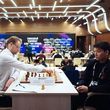Armageddon Now
Maxim Notkin reviews Quarterfinals of the FIDE World Cup
In those two matches that ended in classical chess, the winners were more focused and accurate during the critical moments of play and showed great skill. Tie-breaks, on the other hand, were decided by nerves and luck. As the saying goes, those who made a penultimate mistake made it through.
Grischuk - Ding Liren
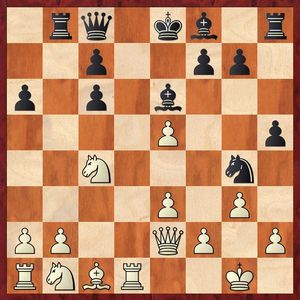
White mishandled a sharp line of the Catalan and must take precautions against Black's looming attack that starts with h5-h4.
Developing the lagging queen's knight does not solve all the problems: 14.Nbd2 h4 15.Nf3 (after15.Nf1 hxg3 16.hxg3 Rb5! regains the e-pawn, as 17.f4 Bd5 is bad for White, and the rook moves on to the h-file) 15...hxg3 16.hxg3, and now the tempting 16...Bd5 17.e4 Bxe4!? 18.Qxe4 Rh1+ runs into 19.Kg2! Rxd1 20.Ncd2!, and Black is forced to return the material, but if he plays 16...Bc5! first, stopping the e-pawn, White's situation becomes problematic.
14.f3 is completely unsatisfactory: 14...h4! 15.fxg4? Bxg4 followed by recaptures on d1 and g3, and after 14.h3 h4! (after 14...Bxc4 15.Qxc4 Nxe5 16.Qe4 Bd6 17.Qg2 Black's initiative evaporates) 15.hxg4 hxg3 16.f3 Rh2 17.Qe1 White survives after 17...Bxc4 18.Qxg3, but Black has a more unpleasant reply – 17...Rf2!, and the white king remains insecure.
14.Qf3. Indirectly protecting the knight: 14...Bxc4? 15.Qxc6+.
14...Rb6. Alas, this original idea is objectively dubious, because Ding has an alternative that gives him a large advantage. To be fair, calculating it through at the board is really difficult. 14...Bd5! 15.Rxd5 (15.Qf4? h4, and White's kingside collapses) 15...cxd5 16.Qxd5 Qf5! 17.Qc6+ Kd8 18.f3 (on 18.Qg2 there is 18...h4 again) 18...Qc2! 19.Nbd2 Qd1+ 20.Nf1 Nxh2! (a correct move order, as20...Rh6? is no good – 21.Qe4 Nxh2 22.Qh4+!) 21.Kxh2 Rh6! (after 21...Qxf1 22.e4 White threatens Bg5+, and Black is forced to give the perpetual 22...Qf2+ 23.Kh3 Qf1+ 24.Kh2) 22.Nd6!? Bxd6! (22...cxd6 is playable too, one just needs to foresee 23.Bd2! Qe2+ 24.Kg1 Qb5, defending against Ba5+) 23.e4 (23.exd6 Qe2+ 24.Kg1 Rxd6 25.Qe4 Rd1) 23...Be7!, and after 24.Bxh6 Qxa1 White is an exchange down and his forces are scattered.
The move in the game gives White a rook for a minor piece, and Black needs to prove his compensation.
15.Nxb6 cxb6
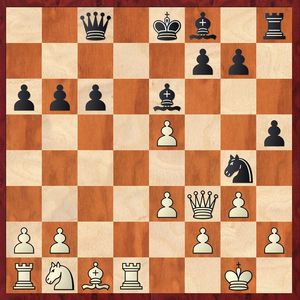
16.h4. Black's threat of pushing the h-pawn was not that dangerous any more. Therefore, White is better off after 16.Nc3 h4 17.h3 Nxe5 (if 17...hxg3 18.Qxg3, Black either needs to retreat or go for unsound sacrifices) 18.Qe4 Ng6 19.g4, and White keeps the kingside shut.
Now the rating favorite of the World Cup begins to play one-move threats, and an advantage gradually passes to Grischuk.
16...Nxe5 17.Qf4 (17.Qe4?! f6 18.Nc3? Bg4 with an attack on the light squares) 17...Ng6 (17...f6!?) 18.Qe4 Be7 19.Nc3 Bf5 (19...0–0) 20.Qh1!
White finally gets time and can start developing the queenside. However, in the subsequent game Alexander missed several promising opportunities and allowed the opponent to create counterplay.
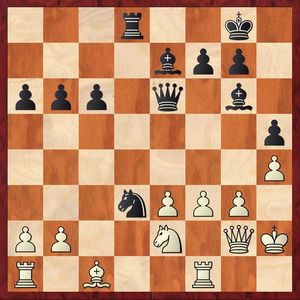
In this position White can try 28.Rd1 c5 (28...Nxc1 29.Rxd8+ Bxd8 30.Rxc1 Qxe3 31.Rxc6) 29.e4, and Black has to deal with 30.Nf4 and 30.Rxd3 Rxd3 31.Nf4.
After the immediate 28.e4 Black is in time for 28...f5 29.exf5 Qxf5, and he eventually managed to make a draw.
The second game of the match was slow and balanced, but as it went on, Ding found weak spots in Black's position, and the time-troubled Grischuk failed to protect them properly.
Ding Liren - Grischuk
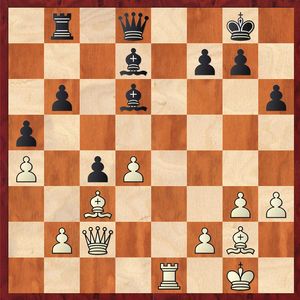
26...Qc7. It is better to support the с4-pawn with the rook from c8, in order to have more options for the queen.
27.h4. By moving the pawn away, White prepares to activate the light-squared bishop.
27...Re8 28.Bd5. On 28.Rxe8+ Bxe8 29.Bd5 Black responds 29...Qd7, counterattacking the а4-pawn.
28...Rxe1+. This natural-looking exchange that logically continues Black's previous actions turns out to be a mistake. The threat of Qg6 could be parried without swapping the rooks by 28...Qc8 29.Qg6 Rxe1+ 30.Bxe1 Be6 31.Bxe6 Qxe6 32.Qxe6 fxe6, and the bishop ending looks drawish. The computer also suggests the illogical 28...Rd8, however, it is obvious that Black is not only bothered by some abstract matter, but is also uneasy about allowing 29.Re3. The cool-blooded defensive trick29...Bf8 30.Rf3 Bxa4! (benefiting from the rook being on d8) solves his problems but is hard to spot.
29.Bxe1. The bishop has retreated, and the c4-pawn is attacked.
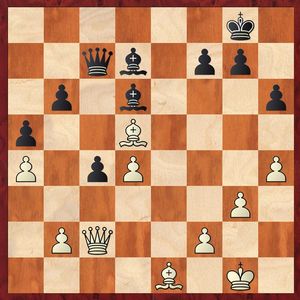
Now after 29...Qc8 30.Bxc4 Black has to accept losing a pawn or jump into questionable complications: 30...Qe8!? 31.Bd2 Bxa4 32.Qg6 Qe7 (after 32...Qd7 33.Bxh6 Bf8 34.Be3 b5 35.Ba2 White keeps the material) 33.Bxh6 Qe1+ 34.Kg2 Bc6+ 35.f3 Qxg3+ 36.Qxg3 Bxg3 37.Kxg3 gxh6 38.Kf4, and this bishop ending looks very dangerous.
Perhaps 29...Bc6 offers decent practical chances. In the case of 30.Qxc4 Bxd5 31.Qxd5 Qc1 32.Qxd6 Qxe1+ 33.Kg2 Qe4+ 34.Kh2 Qc2 Black regains a pawn in a queen ending, an after30.Bxc4 Qd7 his pieces are active, and White needs to worry about long diagonal threats constantly.
The move made by Alexander surprisingly made his position hopeless.
29...Be6? 30.Bxe6 fxe6 31.Qe4. In the concluding phase of the game White attacks the pawns on b6, c4, e6, g7 one by one. There are too many weaknesses for too few defenders!
31...Kf7 (31...Qd7 32.d5, winning one of the pawns) 32.Bc3 Bf8
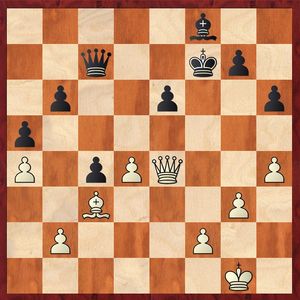
33.d5 Qd6 34.dxe6+ Qxe6 35.Qb7+ Kg8 36.Bd4 Qf5 37.Kh2 Qc2 38.Qd5+ Kh7 39.Qf7 Qd3 40.Bc3. 40.Bxb6 wins easily as well, but Ding Liren shows patience in harvesting, cleverly reacting to the opponent's time trouble.
40...Qd6 41.Qxc4 Qg6 42.Bd4. The pawn on b6 is doomed. Black resigns.
The first game between Radjabov and Xiong lacked excitement, but the crowd was generously rewarded in the second game.
Radjabov - Xiong
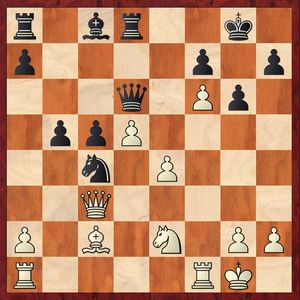
The grandmaster from Azerbaijan took his opponent by surprise in the opening and got a promising position. Then he did not find the best square for his queen, missed the best time for decisive actions, and Black got a chance to create counterplay. However, Xiong's play was not consistent enough.
22...Re8?! After 22...Bd7 or 22...Ne5 Black has a solid and harmonious position with good chances of seizing the initiative. Fragility of the b5-pawn+c4-knight construction provoked Xiong to enter wild complications, but his first line of forces lacked the necessary support of the rear group.
23.Bd3 Ne3 24.Bxb5 (naturally, not 24.Rf3 Ng4 followed by c5-c4 or b5-b4) 24...Rxe4. In the variation 24...Nxf1 25.Bxe8 Qxh2+ 26.Kxf1 Ba6 27.Bc6 Bxe2+ the white king hides on с5, and27...Rb8 runs into the deadly 28.Kf2 Bxe2 29.Qg3! with a won ending.
Black has no attack after 24...Ng4 25.Qg3.
25.Ng3
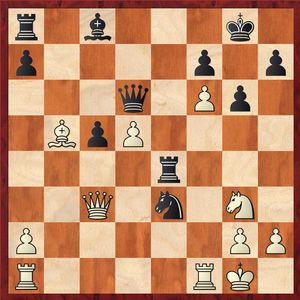
25...Ng4! A brilliant, yet rather desperate decision. Black loses after 25...Re5 26.Rfe1 Ng4 27.Bc6 (or 27.Rxe5 Nxe5 28.Re1 at once, because 28...Bd7 fails to 29.Rxe5 Bxb5 30.Nf5!) 27...Rb8 28.Rxe5 Nxe5 29.Re1 Nd7 30.Re8+ Nf8 31.Qc1 Qxf6 32.h3!, and Black cannot unpin.
26.Rac1. White keeps improving his pieces one by one, while the same cannot be said about Black.
26...c4?! The computer refutes the attempt to remove the sting by 26...Rf4 with a very long and narrow variation: 27.Bc6 Rb8 28.Rxf4 Qxf4 29.Rf1 Qd4+ 30.Qxd4 cxd4 31.h3 Ne3 32.Rf4 d3 33.Re4 Bb7 34.Rxe3 Bxc6 35.Rxd3 (35.dxc6? d2 36.Rd3 Rb1+) 35...Rd8 36.Nf5! gxf5? 37.Rg3+ Kf8 38.dxc6, and White ends up a pawn up.
However, moving the rook away from the attack is safer. After 26...Re5 27.Qxc5 Qxc5+ 28.Rxc5 Bb7 White will not save his passed pawn.
27.h3 Bb7. If 27...Re3 28.Qxc4, Black's back rank weakness forces 28...Nxf6 29.Qc6 Qxc6 30.Bxc6 Rb8 31.Rxf6 Rxg3 32.Re1, and White enjoys a clear edge in the endgame.
28.hxg4
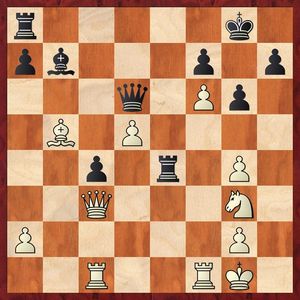
28...Rxg4. After 28...Qc5+ 29.Rf2 (not 29.Kh2? Rxg4 30.Kh3 Bc8 or 30.Bd7 Qxd5, and White loses material) 29...Rf4 30.Rcf1 Rxf2 31.Rxf2 Qxb5 32.Qe3 Kh8 33.Ne4 Qb1+ the agile black queen defends against mating threats in 34.Kh2 Bxd5 35.Qh6 Qb8+ 36.Kg1 Qf8. However, Black has to suffer in the endgame after 34.Rf1 Qb6 35.Qxb6 axb6 36.Rd1.
29.Bc6! Rxg3? 29...Bxc6 30.dxc6 Rxg3 31.Qxc4 Rd3 with some hopes to survive in the endgame with major pieces was Black's best chance.
30.Qxc4 Ba6. 30...Bxc6 is already too late: 31.Qxc6 Qxc6 32.dxc6 Rd3 33.c7 Rc8 34.Rcd1, and Black loses because of his back rank weakness.
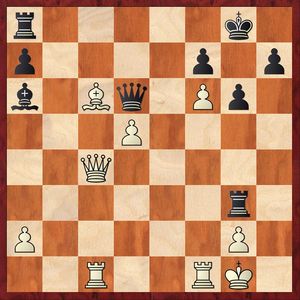
31.Qf4! A very skilled move! There is no need to send the white king on a dangerous journey and look for only moves after 31.Qxa6 Rh3! 32.Qc4! Qh2+ 33.Kf2 Rb8 34.Bb5!
31...Rd8 32.Rce1 Qc5+ 33.Rf2 Rc3 34.Re7. 34.Be8! leads to a subtle finale: 34...Rc2 35.Bxf7+! Kxf7 36.Re7+ Kg8 37.f7+ Kf8 38.Re8+ Rxe8 39.fxe8Q+ Kxe8 40.Qe4+ and 41.Qxc2.
34...Rc1+? 34...Rc2 was Black's last chance: 35.Qe3 (35.Be8 Qxf2+ 36.Qxf2 Rxf2 37.Kxf2 Bc4 38.Bxf7+ Kf8) 35...Qxe3 36.Rxe3 Rc1+ 37.Kh2. Now he is getting mated.
35.Kh2 Rc3 36.Qh6 (36...Qd6+ 37.Rf4). Black resigns.
A bishop move to d7, missed in Vitiugov-Yu Yangyi, also led to very lively events.
Vitiugov-Yu Yangyi
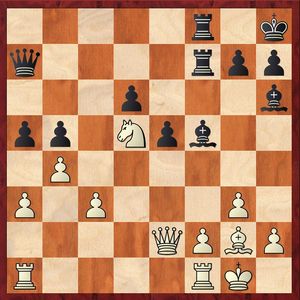
31…Be6?! 31...Bd7 protects the b5-pawn and prevents а3-а4. The move in the game does not even create a threat of 32...Bxd5 33.Bxd5 Rxf2 34.Rxf2? Rxf2 35.Qxf2 Be3, because White has 34.Kh1!
32.Qxb5 Rxf2 33.Kh1 Qa8. Attempting to survive in the ending with opposite-coloured bishopsthat arises after 33...Rxf1+ 34.Rxf1 Rxf1+ 35.Qxf1 Qf7 36.Qxf7 Bxf7 37.bxa5 Bxd5 38.Bxd5 Be3 equals declaring bankruptcy.
33...axb4? loses to 34.Rxf2 Qxf2 (34...Rxf2 35.Qe8+ Bg8 36.Ne7) 35.Rf1 Qxf1+ 36.Bxf1 Rxf1+ 37.Kg2!
33...Bg8 is interesting, intending to create counterplay around the e-pawn after 34.Rxf2 Rxf2 35.bxa5 Qf7, but we are obviously talking about the lesser of evils.
34.Rxf2 Rxf2
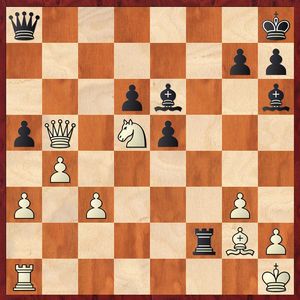
35.Nf4! 35.bxa5? Rxg2 is obviously bad. After 35.Qxa5 Qxa5 36.bxa5 Rxg2? 37.Kxg2 Bxd5+ 38.Kf2 a rook with passed pawns is superior to bishops, therefore Black must go for 35...Qf8 with an unclear position. The move in the game forces Black to part with an exchange.
35...Rxg2 36.Nxg2 axb4 37.Qxb4. 37.cxb4 was calling for and it would ask Black more difficult questions, but with some imagination one could still live: 37...Be3! (37...Bd5 38.Qe2 Bf3 39.Qf2 e4 40.Kg1) 38.a4 h6! (38...Bd5 39.Qf1 Bd4 40.Rc1 Qxa4 41.Rc8+ Bg8 42.Nh4 Qd7 43.Qf5 Qb7+ 44.Nf3) 39.a5 Bd2 40.Rd1 (40.a6 Bd5 41.Qe2 Bxb4) 40...Qe4!
37...Bd5 38.Qb2 Be3 39.a4 h6 40.h3 Bc5 41.Kh2 Bc4 42.Qc2 Qf3 43.Nh4 Qe3
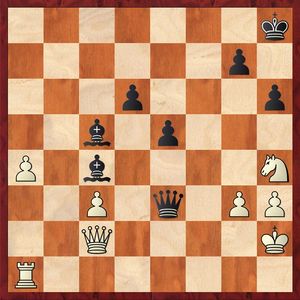
The game was drawn here. Similar to the line above, Black is in great danger, but proving White's advantage without computer aid is hard. For instance, 44.a5 e4 45.Rd1 (45.a6 Bxa6; 45.Nf5 Qf3 46.Nd4 Bxd4 47.cxd4 Be2) 45...g5 46.Nf5 Qf3 47.Nd4 Bxd4 48.Rxd4 d5 with the intention to push the e-pawn.
The players exhausted the limit of games allocated for tie-break and were completely exhausted themselves, too. One can't help feeling sorry for both of them.
Yu Yangyi - Vitiugov
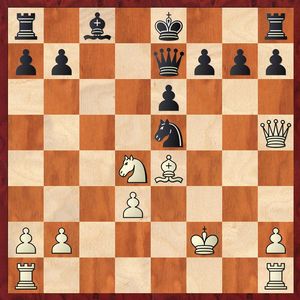
In the Armageddon game, Yu Yangyi blundered two pawns on the 9th move. Here 17...Qc5 yields a whole knight (White's losses after 18.Ke3 Nc4+ are even more severe). However, Nikita played17...Nd7, and the wheel of fortune began to spin in another direction.
Vachier-Lagrave and Aronian followed a similar plot in their second rapid game.
Vachier - Lagrave-Aronian
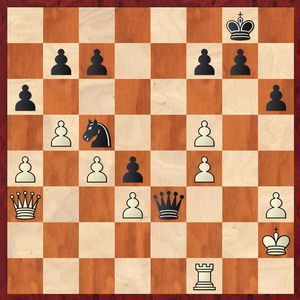
Levon has outplayed Maxime and got a strong attack with an exchange sacrifice. Here it is rather easy to spot 31...Ne4!, and the threat of Qg3+ basically ends the game.
However, instead of that Black opted for 31...Qe2+ 32.Kg1 Nxd3 33.bxa6 bxa6 34.Qb3 Qe3+ 35.Kh2 Qd2+ 36.Kg1 Qe3+ 37.Kh2. Not satisfied with the move repetition, Levon brings in the h-pawn.
37...h5 38.Qd1
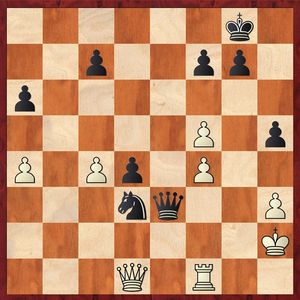
38...h4?? (had Black retreated the knight, the match would probably proceed to 10-minute games) 39.Rf3 Nb2 40.Rxe3 Nxd1 41.Rd3. Black saved the piece, but the endgame is utterly hopeless.
Thus Vachier-Lagrave avenged his loss in the Semifinals of the previous World Cup.




















